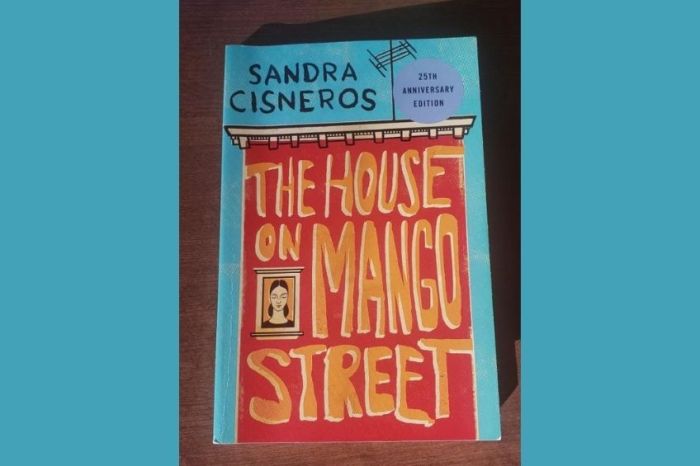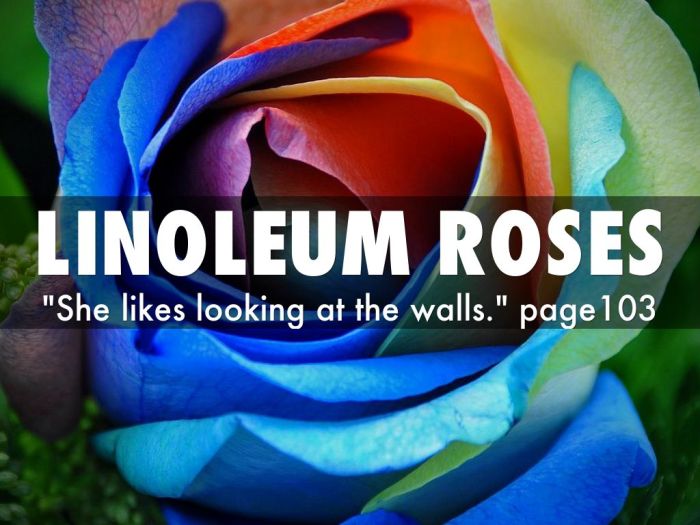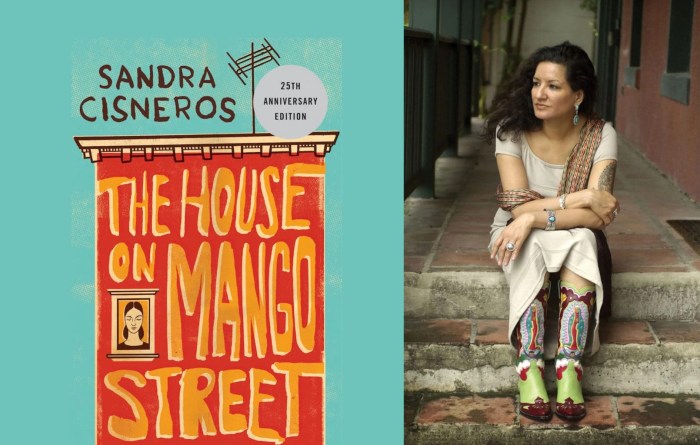House on mango street linoleum roses – Sandra Cisneros’s acclaimed novel, The House on Mango Street, presents a profound exploration of themes related to home, identity, and community through the lens of a young Latina girl named Esperanza. Within this captivating narrative, the recurring motif of linoleum roses emerges as a powerful symbol, embodying Esperanza’s dreams, aspirations, and the complexities of her lived experiences.
Throughout the novel, Cisneros skillfully employs the image of linoleum roses to convey the protagonist’s inner struggles and desires. These artificial flowers, adorning the floors of Esperanza’s modest home, serve as a constant reminder of her yearning for beauty and a sense of belonging.
The Significance of Linoleum Roses

Linoleum roses, a recurring motif in Sandra Cisneros’s “The House on Mango Street,” hold profound symbolic significance, representing the dreams and aspirations of the novel’s protagonist, Esperanza Cordero.
Esperanza’s Dreams and Aspirations
The linoleum roses symbolize Esperanza’s yearning for beauty, love, and a sense of belonging. They represent her desire to escape the poverty and limitations of her neighborhood and create a better life for herself. Esperanza sees the roses as a way to transform her surroundings, to bring color and joy into her life.
Motif of the Roses
The roses appear throughout the novel in various contexts, each time reinforcing their symbolic meaning. For example, when Esperanza first sees the linoleum roses in the kitchen of her new home, she is immediately drawn to their beauty. She imagines them as a symbol of hope and possibility, a reminder that even in the midst of hardship, there is always something to strive for.
Later, when Esperanza witnesses the death of her friend Nenny, she finds solace in the linoleum roses. The roses become a symbol of Nenny’s memory, a reminder of the beauty and fragility of life. Esperanza realizes that even though Nenny is gone, her spirit lives on through the roses.
Esperanza’s Relationship with her Home: House On Mango Street Linoleum Roses

Esperanza’s home on Mango Street is a place of both comfort and confinement. She loves her home and the memories she has made there, but she also feels trapped by its poverty and limitations. Her home shapes her identity in many ways, both positive and negative.
Confinement
Esperanza’s home is a physical and emotional prison for her. She feels trapped by her poverty and the lack of opportunities available to her. She longs to escape her home and find a better life for herself.
- Physical confinement: The house is small and cramped, with little space for Esperanza to move around. She feels like she is suffocating in her home.
- Emotional confinement: Esperanza feels trapped by her family’s expectations. She is expected to conform to traditional gender roles and to marry and have children. She does not feel like she has any control over her own life.
Empowerment
Despite the challenges she faces, Esperanza’s home also empowers her. It is a place where she can be herself and where she can find strength and support from her family. Her home is a source of identity for her, and it helps her to define who she is.
- Physical empowerment: Esperanza’s home is a place where she can feel safe and secure. She knows that she is loved and accepted by her family, no matter what.
- Emotional empowerment: Esperanza’s home is a place where she can learn and grow. She is surrounded by people who care about her and who want her to succeed.
Identity
Esperanza’s home is a central part of her identity. It is where she was born and raised, and it is where she has formed her most important relationships. Her home has shaped her values and beliefs, and it has helped her to become the person she is today.
- Sense of place: Esperanza’s home is a place where she feels connected to her community. She knows her neighbors and feels like she belongs in her neighborhood.
- Sense of self: Esperanza’s home is a place where she can be herself. She does not have to pretend to be someone she is not.
The House as a Symbol of Community
The house on Mango Street represents the larger Latino community in several ways. It is a place where the community gathers to celebrate and mourn, to share stories and food, and to support one another. The house is also a symbol of the struggles and triumphs of the community.
It has been a witness to the hardships that the community has faced, such as poverty, discrimination, and violence. But it has also been a witness to the community’s resilience and strength. The house has been a place where the community has come together to fight for their rights and to build a better future for themselves.
Gathering Place
The house on Mango Street is often used as a gathering place for the community. It is a place where people can come to celebrate and mourn, to share stories and food, and to support one another. For example, in the story “The Family of Little Feet,” the house is used as a gathering place for the community to mourn the death of a young girl.
The community comes together to share stories about the girl and to offer their support to her family.
The Role of the House in the Novel’s Structure

The house on Mango Street serves as the central setting for the novel, providing a physical and emotional anchor for Esperanza and the other characters. Its physical characteristics contribute significantly to the novel’s atmosphere, creating a sense of confinement and claustrophobia that reflects the characters’ limited opportunities and aspirations.
The House as a Symbol of Confinement
The house is small and cramped, with a narrow staircase and tiny rooms. This physical confinement symbolizes the limited opportunities available to the characters. Esperanza and her family are trapped in a cycle of poverty and social inequality, with little hope of escaping their circumstances.
The house becomes a prison, suffocating their dreams and aspirations.
The House as a Symbol of Displacement, House on mango street linoleum roses
The house is also a symbol of displacement and alienation. The Ortegas are constantly moving from one house to another, never feeling truly at home. This lack of stability reflects the characters’ search for a sense of belonging and identity in a rapidly changing world.
The house becomes a temporary shelter, a place where they can hide from the outside world but never truly feel at home.
The House as a Place of Community
Despite its negative connotations, the house also serves as a place of community for the characters. It is a place where they can gather, share stories, and support each other through difficult times. The house becomes a sanctuary, a place where they can escape the harsh realities of the outside world and find solace in each other’s company.
The House as a Literary Device

The house on Mango Street serves as a powerful literary device in Sandra Cisneros’s novel, exploring profound themes of home, identity, and community. The house’s rich symbolism contributes significantly to the novel’s overall message, capturing the complexities of growing up as a young Latina woman in a marginalized neighborhood.
The House as a Symbol of Home
The house on Mango Street embodies the protagonist Esperanza’s longing for a sense of belonging and stability. Esperanza’s desire for a “real” home reflects her search for an identity that is rooted in a place where she feels accepted and valued.
The house’s dilapidated condition and cramped quarters symbolize the challenges and limitations faced by Esperanza and her family as they navigate their social and economic circumstances.
The House as a Symbol of Identity
The house also functions as a symbol of Esperanza’s evolving identity. As she grows and matures, the house becomes a mirror reflecting her own experiences and aspirations. The changes and additions made to the house over time parallel Esperanza’s own journey of self-discovery and empowerment.
The house serves as a tangible representation of her growth and the ways in which she shapes her own identity amidst the complexities of her surroundings.
The House as a Symbol of Community
Furthermore, the house on Mango Street plays a vital role in fostering a sense of community among the residents of the neighborhood. The shared experiences of living in a cramped and underprivileged space create a bond between the families. The house becomes a gathering place where they share stories, support each other, and find solace in their collective struggles.
The community formed within the house highlights the importance of human connection and the power of shared experiences in shaping a sense of belonging.
The House as a Device for Creating Realism and Authenticity
The house on Mango Street is also instrumental in creating a sense of realism and authenticity in the novel. The detailed descriptions of the house’s physical condition, the neighborhood, and the people who live there immerse the reader in Esperanza’s world.
The house’s imperfections and the challenges faced by its inhabitants reflect the harsh realities of life in a marginalized community. This realism lends credibility to Esperanza’s story and allows readers to connect with her experiences on a deeper level.
Commonly Asked Questions
What is the significance of the linoleum roses in The House on Mango Street?
The linoleum roses represent Esperanza’s dreams and aspirations, as well as her desire for beauty and a sense of belonging.
How does Esperanza’s home both confine and empower her?
Esperanza’s home provides her with a sense of security and stability, but it also limits her opportunities and reinforces societal expectations.
In what ways does the house on Mango Street represent the larger Latino community?
The house reflects the struggles and triumphs of the Latino community, providing a gathering place and a symbol of resilience.
